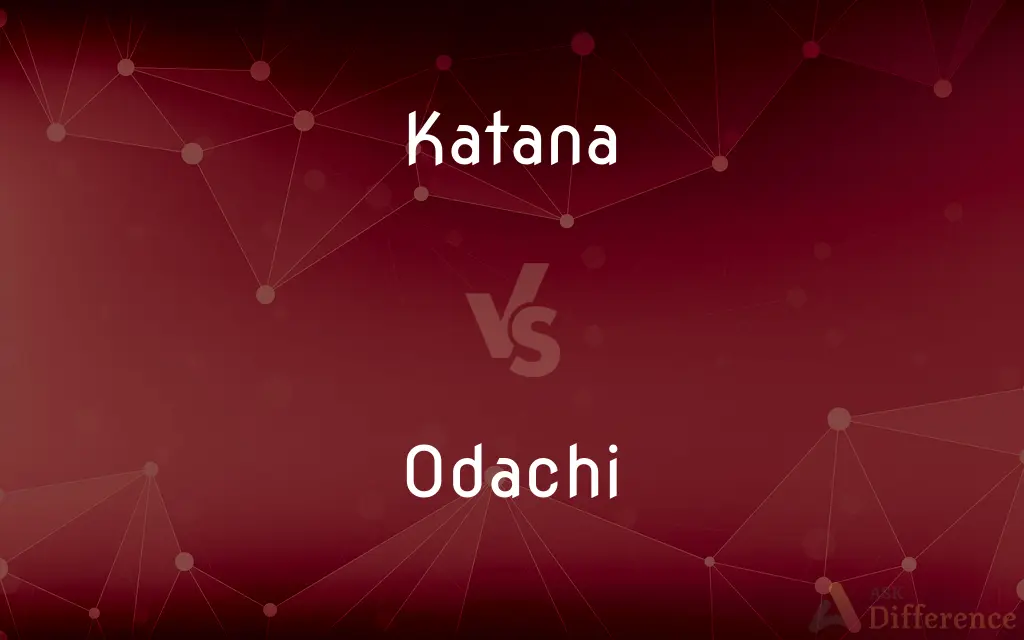Katana vs. Odachi — What's the Difference?
Edited by Tayyaba Rehman — By Urooj Arif — Updated on April 15, 2024
Katana is a shorter, more versatile Japanese sword used primarily for cutting, while Odachi is a larger, heavier sword designed for battlefield reach and impact.

Difference Between Katana and Odachi
Table of Contents
ADVERTISEMENT
Key Differences
The katana is a traditional Japanese sword characterized by its curved, slender, single-edged blade, circular or squared guard, and long grip to accommodate two hands. Whereas the Odachi, also known as ōdachi, features a significantly longer blade and handle, which makes it less practical for close combat but advantageous for striking from a distance.
Katanas are typically about 60-80 cm long and are known for their sharpness and relatively light weight, which makes them excellent for swift, precise cuts. On the other hand, an Odachi is often over 100 cm long, making it cumbersome and less manageable in tight spaces or close-quarter fighting.
Historically, the katana gained prominence among the samurai of feudal Japan due to its effectiveness as a cutting weapon in one-on-one combat. In contrast, the Odachi was used more ceremonially and on the battlefield for its reach, allowing soldiers to strike enemies from behind the front lines.
In terms of use and handling, the katana is more suited to the martial art of kenjutsu, where speed, agility, and precision are crucial. The Odachi requires different techniques, focusing more on momentum and the arc of the swing due to its size and weight.
Culturally, both swords hold significant places in Japanese history and culture, though the katana is more commonly recognized globally as a symbol of the samurai spirit and Japanese craftsmanship. The Odachi, while respected, is less prevalent in popular culture and is often seen more in historical and ceremonial contexts.
ADVERTISEMENT
Comparison Chart
Length
60-80 cm
Over 100 cm
Weight
Lighter, easier to handle
Heavier, requires more strength
Use
Close combat, one-on-one
Battlefield reach, ceremonial
Handling
Requires agility and precision
Focuses on momentum and swing arc
Cultural Symbol
Symbol of samurai spirit
Less common, mainly historical value
Compare with Definitions
Katana
Designed for cutting rather than stabbing.
The katana’s edge is perfect for slicing through objects.
Odachi
Often ceremonial due to its size and weight.
The Odachi was displayed prominently during the parade.
Katana
Requires skill and precision to wield effectively.
He trained for years to master the techniques of the katana.
Odachi
Used historically on the battlefield for its reach.
The soldiers used the Odachi to strike at mounted enemies.
Katana
Known for its sharpness and craftsmanship.
The katana is often forged from multiple layers of steel.
Odachi
Requires considerable strength and technique to handle.
Handling an Odachi effectively demands rigorous training.
Katana
A traditional Japanese sword with a curved blade.
The samurai unsheathed his katana with a swift motion.
Odachi
A large, two-handed Japanese sword.
The Odachi was too large to be practical in crowded combat.
Katana
Used primarily by the samurai in feudal Japan.
The katana was a symbol of the samurai’s authority and skill.
Odachi
Less common than other traditional Japanese swords.
Authentic Odachi are rare and highly prized by collectors.
Katana
A katana (刀 or かたな) is a Japanese sword characterized by a curved, single-edged blade with a circular or squared guard and long grip to accommodate two hands. Developed later than the tachi, it was used by samurai in feudal Japan and worn with the blade facing upward.
Odachi
A long, large Japanese sword.
Katana
A long, single-edge sword for use with two hands, traditionally worn by samurai.
Odachi
A long Japanese sword built like the katana but longer (about 4 to 6 feet long), for combat on horseback.
Katana
A type of Japanese longsword or tr=nihontō, having a single edge and slight curvature, historically used by samurai and ninja.
Common Curiosities
What is the main functional difference between a katana and an Odachi?
The katana is designed for agility and precise cuts in close combat, while the Odachi is suited for reaching enemies from a distance due to its length.
How were katanas and Odachis made?
Both swords were traditionally made using a steel forging technique known as folding, which involved layering and hammering the steel to remove impurities and strengthen the blade.
Are there specific martial arts that focus on the katana or Odachi?
Kenjutsu and Iaido are martial arts that primarily focus on techniques involving the katana. Techniques using the Odachi are less common but can be found in some classical ryuha (schools).
Why is the katana more recognized than the Odachi?
The katana is emblematic of the samurai, widely regarded and depicted in media, making it more recognized globally than the more specialized and less frequently used Odachi.
Can the Odachi be used effectively in one-on-one combat?
Due to its size and weight, the Odachi is less practical for one-on-one combat compared to the more manageable katana.
Is the Odachi still used today?
Today, the Odachi is primarily used in ceremonial contexts or collected as part of martial arts history and antique weaponry, rather than for practical combat.
What are the historical origins of the katana and Odachi?
The katana evolved in the late 12th century for samurai class, optimized for quick drawing and cutting techniques, while the Odachi dates back to the earlier Heian period, used originally by infantry for combating cavalry.
How did warriors carry the Odachi, given its size?
Due to its length, the Odachi was often carried on the back or held by an attendant as it was too long to be worn at the waist like the shorter katana.
What are the cultural impacts of the katana in modern times?
The katana remains a powerful symbol in Japanese culture, representing the bushido code of the samurai, and has a significant impact on film, literature, and various art forms worldwide.
What is the significance of the katana's curved blade?
The curve of a katana's blade helps in delivering effective slicing cuts and allows for a smoother, faster unsheathing action, which was crucial during samurai duels.
Can the techniques of the katana be applied to using an Odachi?
While some fundamental principles overlap, the Odachi requires adaptations in technique due to its greater length and weight, emphasizing broad, sweeping strokes and momentum control.
How does the balance of a katana compare to that of an Odachi?
The katana is generally well-balanced for one-handed or two-handed use, enhancing its versatility in combat, while the Odachi’s balance is geared towards two-handed power strikes, given its length and weight.
What role did the Odachi play in Japanese ceremonies?
The Odachi was often used in ceremonial roles, such as blessings for warriors or as offerings at shrines, due to its impressive size and the skill required to forge one.
How are modern reproductions of katanas and Odachis different from historical ones?
Modern reproductions may use contemporary steel and manufacturing techniques, potentially lacking the traditional craftsmanship, which includes hand-forging and differential tempering, that characterized historical katanas and Odachis.
Were katanas or Odachis ever used by foot soldiers?
Katanas were widely used by foot soldiers, especially during the Edo period, whereas the Odachi’s use by foot soldiers was limited due to its impracticality in tight formations.
Share Your Discovery

Previous Comparison
Unsanitary vs. Insanitary
Next Comparison
Catalogue vs. InventoryAuthor Spotlight
Written by
Urooj ArifUrooj is a skilled content writer at Ask Difference, known for her exceptional ability to simplify complex topics into engaging and informative content. With a passion for research and a flair for clear, concise writing, she consistently delivers articles that resonate with our diverse audience.
Edited by
Tayyaba RehmanTayyaba Rehman is a distinguished writer, currently serving as a primary contributor to askdifference.com. As a researcher in semantics and etymology, Tayyaba's passion for the complexity of languages and their distinctions has found a perfect home on the platform. Tayyaba delves into the intricacies of language, distinguishing between commonly confused words and phrases, thereby providing clarity for readers worldwide.
















































